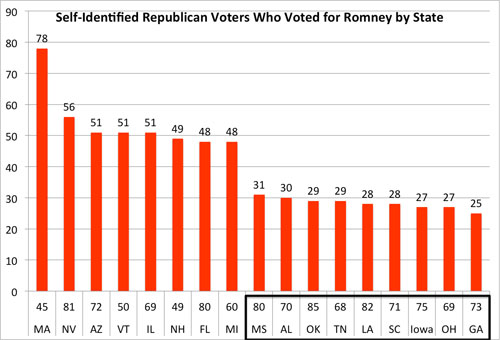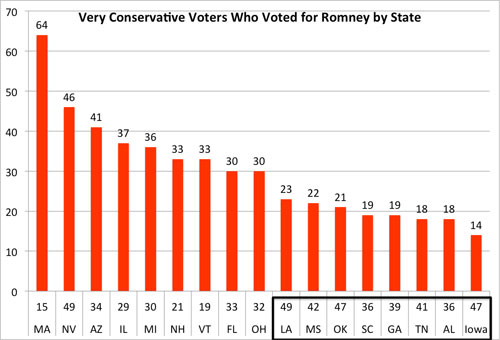
Michael Bitzer
A few days ago, I wrote about how Dixie might be derailing Mitt’s chances of gaining the GOP’s presidential nomination. Now that we are about halfway through the Republican presidential primary process (Romney has nearly half of the 1,144 delegates needed for the nomination), I wanted to revisit some of the key exit poll results in the states. But this time, I sorted the results based on Romney’s support, in descending order, among specific voting groups in the various states.
Many would label the following groups are core factions to the modern GOP Party: self-identified Republicans (of course), those voters who consider themselves “very conservative,” evangelical voters, voters who are strong supporters of the tea party movement, voters who are seeking a “true conservative” for their nominee, and those who want to defeat President Obama.
And in particular, according to two political scientists who wrote the book on “Divided America” and the importance of regionalism in our nation’s politics, the South is a crucial foundation for the GOP.
So, using the exit polls in the contests held so far, how’s the front-runner doing among these various groups?
Let’s take self-identified Republicans. Sorting the various states by the descending level of support given to Romney, we see key states emerge at the very bottom in terms of Romney’s support (those highlighted in the black box—the numbers above the state’s abbreviation indicate the group’s size in the primary electorate).

Mississippi, Alabama, Louisiana, Oklahoma, Tennessee, South Carolina, Iowa, Ohio, and Georgia are all at the bottom when it comes to Republican voters who support Romney’s bid for the GOP nomination.
How about those voters who consider themselves “very conservative?”

While not necessarily in the same order, it’s the same old gang of states that show the least support to Romney among very conservative voters: Louisiana, Mississippi, Alabama, Oklahoma, Tennessee, South Carolina, Iowa, and Georgia.
What about strong supporters of the Tea Party? What’s Romney’s support like among those key voters who gave the GOP the land slide win just two years ago?

OK, I’ll be honest — at this point, it’s just easier to cut and paste from above, because the same culprits show up: Louisiana, Mississippi, Alabama, Oklahoma, Tennessee, South Carolina, Iowa, and Georgia.
When it comes to evangelical/born-again Christians—well, as my father used to tell me, “I’ll give you three guess, and the first two don’t count.”

Is there any good news for Mitt among his party’s base of supporters? Well, it would seem that Republicans—no matter the state—really want to defeat President Obama, and with that said, here are the descending results as well:

But, alas, it’s the same states at the bottom of that group as well.
Finally, how about those voters who believe the most important quality in their presidential nominee is being a “true conservative?” Well, here we get one slight change from the above results:

It’s our typical gang of eight, but including Nevada in the middle of the pack.
But if you take these eight states so far, you are looking at among the most reliable Republican red states in the nation — with all of them, save Iowa, being Southern (or, in Oklahoma’s case, Southern-like).
Now, I’m not saying that this Dixieland Gang of 8 are going to align themselves with the Democratic blues in November. These states remind me of the old Southern saying about voters in the mid-20th Century Democratic Solid South: “I’d rather vote for a yellow-dog than a Republican.”
These states are now willing to vote for Old Yeller over a Democrat, it seems — and Mitt may be hoping he’s that yellow dog in November.
But it’s very unusual, to put it mildly, to see a frontrunner who does everything he can to sell himself to his own party’s base. And unlike the run on EtchaSketchs of late, loyal GOP consumers — the grassroots who make up the brand — just ain’t buying what Mitt’s selling.
 The world of food has never been more competitive. Top chefs, iron chefs and cake bosses are stepping up to challenges on chopping blocks all around the U.S. and abroad.
The world of food has never been more competitive. Top chefs, iron chefs and cake bosses are stepping up to challenges on chopping blocks all around the U.S. and abroad.





















